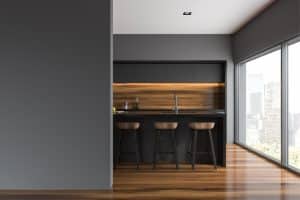Which Factors Influence Choosing Shades Of Grey For Walls?

Grey walls have become a popular choice in modern interior design, offering a versatile and sophisticated backdrop for various styles and colours. But with so many shades of grey colours available, choosing the perfect one can feel overwhelming. Several factors influence this decision, ensuring you achieve the desired effect in your space.
What effect do you want to achieve with your grey walls?
The first step is considering the overall feel you want to create. Light shades of grey colours, like light dove or greige (a blend of grey and beige), promote a sense of spaciousness and openness, making them ideal for smaller rooms. They also reflect light, creating a brighter and airier atmosphere.
Conversely, darker shades of grey colours, such as charcoal or smoky grey, add drama and sophistication. They can be perfect for creating a more intimate setting in larger rooms or defining specific areas within an open floor plan. However, it’s crucial to consider the natural light in the room. In spaces with limited natural light, darker shades of grey colours can make the room feel smaller and even cave-like.
How does the size and natural light of the room influence your choice?
As mentioned earlier, the size and natural light of the room significantly impact your choice of grey colour. As a general rule, lighter shades of grey colours work best in smaller rooms to avoid making the space feel cramped. Conversely, rooms with abundant natural light can handle darker shades of grey colours beautifully.
Furthermore, the direction the room faces can also influence your choice. North-facing rooms tend to receive cooler light. In such cases, opting for shades of grey colours with warmer undertones, like beige or yellow, can help counteract the coolness and create a more inviting atmosphere.
What existing furniture and decor will be paired with the grey walls?
The existing furniture and decor in the room play a crucial role in selecting the perfect shade of grey colour. Consider the undertones of your furniture – are they warm (think wood tones) or cool (think metal accents)? Choosing a shade of grey colour that complements these undertones will create a cohesive and balanced look.
Remember, grey walls can act as a fantastic backdrop for pops of colour. Bold furniture pieces or artwork can stand out beautifully against a neutral grey canvas. If you’re looking for a more dramatic statement, consider creating a two tone feature wall using a contrasting colour alongside your chosen shade of grey. This can be a great way to add visual interest and define a specific area within your space. If you have a specific colour scheme in mind for the space, consider how the different shades of grey colours will interact with those colours to achieve the desired aesthetic.
What are the undertones of the different shades of grey colours?
It’s important to understand that not all shades of grey colours are created equal. While they may appear similar at first glance, most greys have subtle undertones that can significantly impact the overall feel of the room. These undertones can be warm (beige, yellow) or cool (blue, green).
Warm greys are known for creating a cosy and inviting atmosphere. They pair well with natural materials like wood and woven textures. Cool greys, on the other hand, exude a more modern and sophisticated vibe. They can be a great choice for creating a sleek and contemporary look, especially when paired with metallic accents or clean lines. Identifying the undertones of different shades of grey colours will help you choose a shade that complements the existing elements in your space and creates the desired mood.
While choosing the perfect shade of grey for your walls is essential, ensuring a flawless finish is equally important. A high-quality paint job can make all the difference, but it also requires proper preparation and attention to detail. If you’re struggling with cracks in your walls, consider seeking professional help from experts.
How can you test different shades of grey colours before committing to a full paint job?
Before diving headfirst into painting your entire room, it’s wise to test out different shades of grey colours to ensure you’ve made the right choice. Here are a few ways to do so:
- Order paint samples: Most paint stores offer small sample pots of paint. This allows you to paint swatches on your wall and observe them in different lighting conditions throughout the day.
- Use online visualization tools: Several online tools allow you to upload a picture of your room and virtually test different paint colours on the walls. This can be a helpful way to narrow down your options before committing to buying paint samples.
- Consider temporary solutions: If you’re still unsure, you could even paint a large piece of poster board with different shades of grey colours and move it around the room at different times of the day to see how they interact with the natural and artificial light.
What additional factors should you consider when choosing shades of grey colours for your walls?
There are a few other factors to keep in mind when making your final decision:
- Existing trim colour: The colour of your existing trim can also influence your choice of grey colour. For a seamless look, consider choosing a shade of grey that complements the trim colour.
- Level of sheen: Paint comes in various sheens, such as flat, eggshell, satin, and semi-gloss. The sheen you choose will impact the overall look and feel of the space. Flat finishes are great for hiding imperfections, while glossier finishes can reflect light and make the space feel brighter. Consider the desired effect and the amount of natural light in the room when choosing the sheen level.
- Quality of paint: While it may be tempting to go for the cheapest option, remember that the quality of paint can significantly impact the final outcome. Higher-quality paints offer better coverage, a smoother finish, and greater durability, saving you time and money in the long run.
Remember, investing in quality paint and meticulous preparation are crucial for achieving a flawless and long-lasting finish, ultimately contributing to a more efficient way to paint an interior room.
Conclusion
Choosing the perfect shade of grey colour for your walls doesn’t have to be a daunting task. By considering the factors discussed above, you can make an informed decision that complements your existing decor, creates the desired atmosphere, and reflects your style. If you’re looking for a modern and sleek look, consider incorporating textured frameless shower screens into your bathroom design. These stylish and functional screens can add a touch of sophistication while complementing your grey walls.
Remember, experimentation is key – don’t be afraid to test out different shades and don’t hesitate to seek help from professionals if needed. With careful planning and consideration, you can transform your space with the timeless elegance of grey walls.
Now that you’re armed with the knowledge to choose the perfect shade of grey for your walls, it’s time to bring your vision to life! Painting a room yourself can be a time-consuming project, and achieving a flawless finish requires a skilled hand. We understand the importance of getting it right, especially when it comes to the subtle nuances of different shades of grey.
That’s where Mi Painting comes in. Our team of expert painters in Sydney are passionate about interior painting and understands the intricacies of working with various shades of grey. They’ll ensure a smooth, even application that makes your walls the stunning backdrop you desire.
Contact us today for a free quote and consultation. Our friendly team is happy to discuss your project and help you achieve the perfect results. Let us take the stress out of painting so you can sit back and enjoy your beautiful new space.




